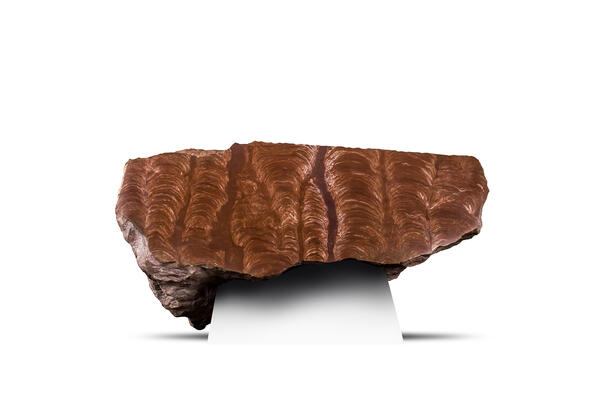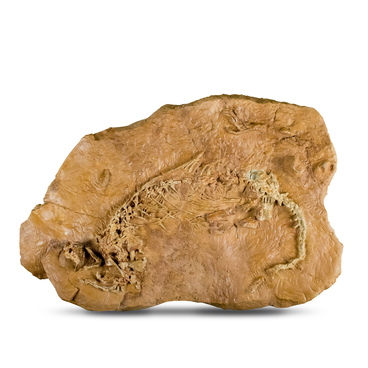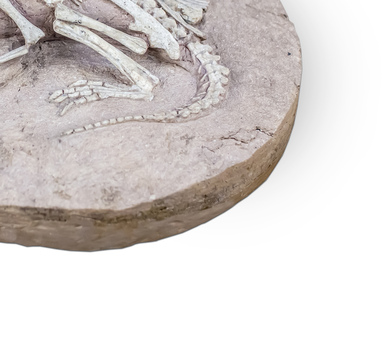The word stromatolite in Greek means ‘stony carpets’. Stromatolites are thinly layered sedimentary formations of different shapes. They were formed due to microbial byproducts of cyanobacteria — microorganisms that are capable of photosynthesis.
Stromatolites can be found on all continents, in rocks of different ages. The oldest ones of them were found in Australia and South Africa, in 3.5 billion years old rocks. Scientists have known about stromatolites since the 19th century; however, they were able to determine their origin only in the middle of the 20th century when modern specimens were found. Low reef flats — up to one and a half meters high — were discovered in Shark Bay in Western Australia. Scientists managed to determine that these reefs were created by cyanobacteria. When their composition was analyzed, it appeared that they were similar in structure to ancient fossilized stromatolites.
Cyanobacteria are intermediate organisms between bacteria and algae. Earlier, they were called blue-green algae, but the term was not accurate. These organisms live in colonial aggregates or separately. Photosynthetic pigments, including various forms of chlorophyll, produce different shades such as pinkish, yellowish, and blue-green. Colonies of cyanobacteria are called mats. They are usually found in shallow waters, but at the same time, can be found in the soil. Some types of cyanobacteria are toxic; hence, fish massively die during the so-called ‘water blooming’.
Modern-day cyanobacterial mats form mainly in warm seas, closer to the shore. The upper layer of the seas is covered with carbonate sediments. Bacteria from the lower layers constantly move up, and at the same time, structure the sediment particles, from which thinly layered stromatolites gradually form.
According to a commonly accepted scientific hypothesis, more than two billion years ago, cyanobacteria, as the first photosynthetic organisms on Earth, affected the rise in oxygen in the Earth’s atmosphere. It resulted in the Great Oxidation Event — the changes in the atmosphere which enabled the formation of new flora and fauna. Later the global glaciation happened which lasted for about 300 million years. Simultaneously, the greenhouse effect was sharply reduced, and the ozone layer was formed around the Earth, which protected it from cosmic radiation. Only after that, the planet truly became habitable.
Stromatolites can be found on all continents, in rocks of different ages. The oldest ones of them were found in Australia and South Africa, in 3.5 billion years old rocks. Scientists have known about stromatolites since the 19th century; however, they were able to determine their origin only in the middle of the 20th century when modern specimens were found. Low reef flats — up to one and a half meters high — were discovered in Shark Bay in Western Australia. Scientists managed to determine that these reefs were created by cyanobacteria. When their composition was analyzed, it appeared that they were similar in structure to ancient fossilized stromatolites.
Cyanobacteria are intermediate organisms between bacteria and algae. Earlier, they were called blue-green algae, but the term was not accurate. These organisms live in colonial aggregates or separately. Photosynthetic pigments, including various forms of chlorophyll, produce different shades such as pinkish, yellowish, and blue-green. Colonies of cyanobacteria are called mats. They are usually found in shallow waters, but at the same time, can be found in the soil. Some types of cyanobacteria are toxic; hence, fish massively die during the so-called ‘water blooming’.
Modern-day cyanobacterial mats form mainly in warm seas, closer to the shore. The upper layer of the seas is covered with carbonate sediments. Bacteria from the lower layers constantly move up, and at the same time, structure the sediment particles, from which thinly layered stromatolites gradually form.
According to a commonly accepted scientific hypothesis, more than two billion years ago, cyanobacteria, as the first photosynthetic organisms on Earth, affected the rise in oxygen in the Earth’s atmosphere. It resulted in the Great Oxidation Event — the changes in the atmosphere which enabled the formation of new flora and fauna. Later the global glaciation happened which lasted for about 300 million years. Simultaneously, the greenhouse effect was sharply reduced, and the ozone layer was formed around the Earth, which protected it from cosmic radiation. Only after that, the planet truly became habitable.



